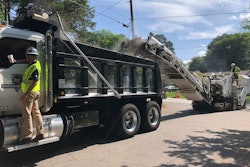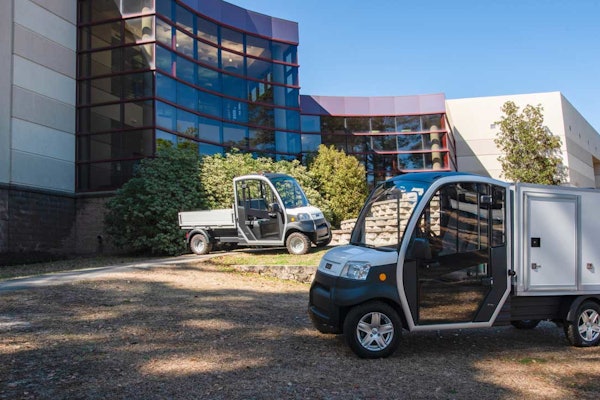 Photo: CLCA
Photo: CLCAWhether you’ve just entered the green industry or have been working in the landscaping field for years, you might have never taken the time to see what your state landscape association has to offer.
We talked to several different state landscape associations to get the scoop on what purpose they serve and the benefits of becoming a member. If you’ve ever been on the fence about joining an association, check out the information below to learn more about what a membership provides.
The purpose of state associations
Depending on which state landscape association you talk to, the wording of the goal of each organization varies slightly, but all of the landscape trade associations work to make their member companies more successful.
 Photo: Gail Woolcott
Photo: Gail WoolcottSandra Giarde, executive director of the California Landscape Contractors Association (CLCA) says, “CLCA’s mission is to serve and protect the interests of its members, promote professionalism and advance public awareness of the landscape industry.”
Meanwhile, the New Jersey Landscape Contractors Association (NJLCA) is dedicated to advancing the integrity, proficiency and continued growth of the landscape industry.
The Arizona Landscape Contractors Association (ALCA) says it helps landscape contractors by promoting continued education, effective business practices and networking opportunities and ensuring responsible legislation to enhance the professionalism of members and the public’s perception of landscape contractors and the green industry.
The majority of the landscape trade associations were formed in the 50s and 60s, with CLCA starting in 1952, the Associated Landscape Contractors of Colorado (ALCC) in 1962, ALCA in 1963 and NJLCA in 1966.
Despite officially forming in 1952, Giarde says CLCA had been working on California’s landscape contractors’ behalf well before then.
“CLCA’s roots were born locally, as far back as the 1930s, as there were three regional landscaping trade groups, each working on behalf of the industry,” she says. “Realizing that other trades wished to limit the work landscape contractors could do under their C-27 license, the regional groups banded together and the statewide CLCA was created.”
The benefits of membership
Since these landscape trade associations have formed, they have grown to offer a number of programs designed to aid landscape professionals in various ways.
 NJLCA hosts a number of social events to encourage member networking.
NJLCA hosts a number of social events to encourage member networking.Photo: Joe Bolognese
One of the most obvious benefits of membership is the ability to network with peers.
“What I have seen as the most valuable benefit over the last 13 years is the knowledge shared between members when they are at a meeting or event of the association and the relationships created, which tend to lead to increased business and savings for all,” says Gail Woolcott, director of operations for NJLCA. “Finally, seeing other contractors doing well tends to lead to increased professionalism.”
State associations also strive to increase professionalism by providing numerous training and certification programs for its members. For example, ALCA offers basic irrigation tech training, sustainable business practices training among other educational opportunities for its members.
“Education has proven to be one of the biggest benefits,” says Judy Gausman, CEO of ALCA. “The certifications that ALCA provides is well recognized, not only in the industry, but also with HOAs and community managers.”
 Photo: Courtesy of Arizona Landscape Contractors Association
Photo: Courtesy of Arizona Landscape Contractors AssociationGiarde says CLCA also provides sustainability education in the form of its EPA WaterSense certified CLCA Water Manager certification program and its collaborative work on sustainable landscaping during its Sustainable Landscape Summits.
Both the networking and training opportunities are held throughout the year at various events. The associations create these events based off of member feedback and industry needs.
“We try to poll our members at meetings and events to find out what they would like to attend,” Woolcott says. “We mix it up with many educational events, along with some really fun social events.”
John McMahon, CEO of ALCC, says they look at areas they need to focus on as an industry and creates events related to those topics. ALCC also puts on one of the largest landscape shows in the country, ProGreen EXPO.
ALCA also has an annual trade show, as well as member mixers and around 100 educational workshops each year for its members.
 Photo: CLCA
Photo: CLCA“CLCA has a fantastic events committee and education committee who do a lot of work searching, brainstorming and talking to members about what they need and want to learn about,” Giarde says. “CLCA’s leadership and staff also keep an eye on upcoming trends and developments and regulations so our membership can be aware and keep their skills sharp. When we do our webinar-based education, those are recorded and then posted in our members only section so members can access them 24/7/365.”
Another major aspect of state landscape associations is the advocacy they can provide. Often times these organizations partner with other concerned parties to ensure that the legislation and regulations passed help, not hurt, professional landscapers.
Some of the recent advocacy wins these associations have achieved include ALCC partnering with the Accredited Snow Contractors Association (ASCA) to lobby for legislature that would limit the liability of snow removal companies. The Snow Removal Service Liability Limitations Act was signed into law on May 30, 2018.
In Arizona, ALCA is a part of the Arizona State Contractors Coalition (ASCC) which is an alliance of construction industry associations dedicated to furthering and protecting the interests of the construction industry. Gausman says they were instrumental on the passage of SB 1271, which passed on April 10, 2019.
 Photo: ALCC
Photo: ALCC“SB 1271 will change Arizona law so contractors that make a mistake on a residential construction project will only pay their fair share of the loss,” Gausman says. “The liability will not be passed along to the contractors who did nothing wrong.”
Meanwhile in California, a legislator was trying to raise the price threshold from for projects that require a licensed contractor. The legislator wanted to raise that threshold from any project over $500 requiring a licensed contractor to where a consumer could hire unlicensed contractor for any project under $25,000.
“For California consumers, a licensed contractor means you are working with a professional who passed an exam on their trade, passed a second exam on business law/practices, is insured and is bonded,” Giarde says. “Our members take their licensed status very seriously and CLCA was at the forefront of killing that proposed change.”
 Photo: CLCA
Photo: CLCAWoolcott says the NJLCA has been working with the local congressmen to repair the H-2B worker program. The organization has also been working with local municipalities to avoid blower bans.
“We have been successful in one town but are currently in litigation with another,” Woolcott.
One benefit that varies on the state association is the ability to earn customer leads. Both ALCC and CLCA offer a search tab on their websites that allows potential clients to find landscape contractors in their area.
McMahon says the find a pro tab on ALCC’s site is pretty effective in finding customers for its member companies, but he says it isn’t a main driver for businesses.
“Our members get quite a few prospective customers from our CLCA Find A Contractor search feature which connects the public to CLCA landscape contractors across California,” Giarde says. “In fact, that page alone gets over 20,000 unique hits per month!”
Another benefit that CLCA provides its members are business assistance programs.
“Being a member of CLCA, they have complimentary access to our HR on Call and Attorney on Call services,” Giarde says.
Pricing and membership growth
As for how much membership costs, this all depends on which association you’re looking at, as well as your company’s sales.
 Photo: CLCA
Photo: CLCAFor ALCC, membership starts at $390 and goes all the way up to $2,500 based on the gross sales of the company. Similarly, NJLA membership levels range from $235 to $435 a year, based on gross sales as well.
ALCA’s fees for contractors vary from $275 to $880 and is based on the annual sales revenue.
For others in the industry such as vendors, allies (government, educators and out of state contractors) and others the prices vary greatly.
“Membership dues investment varies based on your role in the industry (landscape contractor, vendor/supplier, student, etc.) and the size of your business,” Giarde says.
Both Woolcott and Gausman say their associations’ membership has been growing over the past five years while McMahon and Giarde note that they’ve seen a lot of membership consolidation as of late due to recent mergers and acquisitions.









